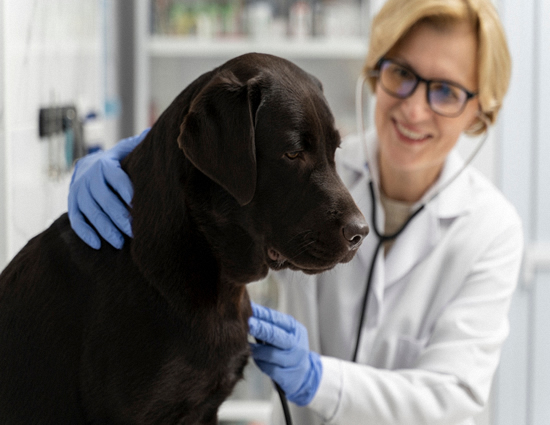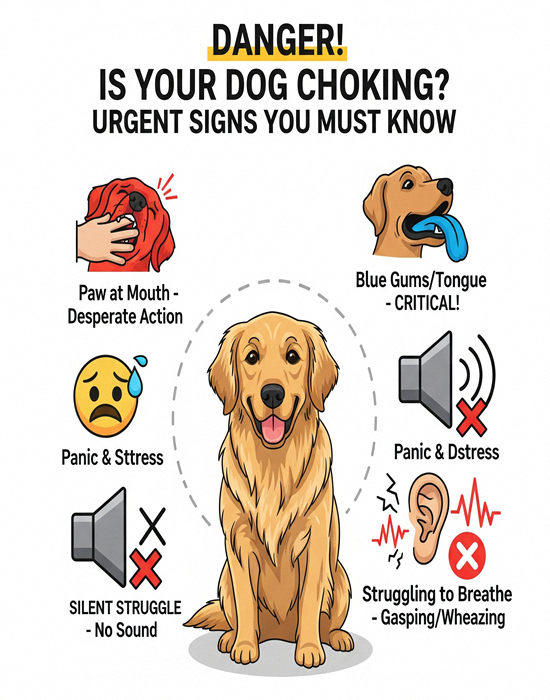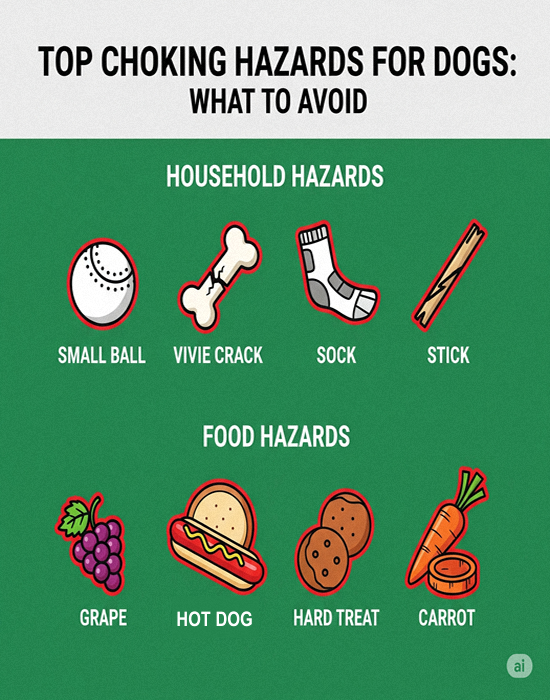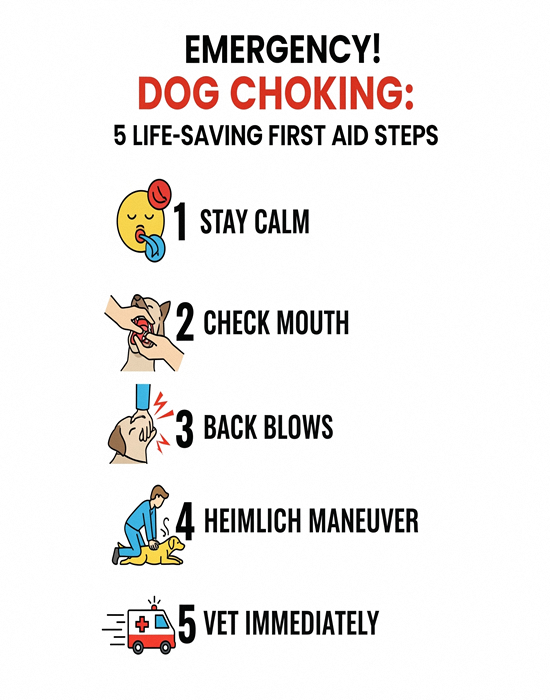Choking in Dogs Symptoms: Urgent Signs Every Pet Parent Must Know

Few moments are as terrifying for a dog owner as watching their beloved companion struggle to breathe. Choking in dogs can escalate from a startling cough to a life-threatening emergency in mere seconds, with some studies indicating that a dog can suffer irreversible brain damage in as little as 3-5 minutes without oxygen.
While we hope it never happens, being prepared with the right knowledge can make all the difference. This article will equip you with the essential information to recognize, prevent, and confidently respond to a choking incident, empowering you to act swiftly when every second counts and potentially transforming a tragedy into a tale of survival.
Urgent Signs of Choking
It’s crucial to distinguish between a simple gag or cough and true choking. A dog that is merely gagging or coughing might sound distressed, but they can still move air, often trying to clear their throat and usually recovering quickly. However, if your dog is truly choking, the signs are far more alarming and indicate a severe airway obstruction requiring immediate intervention. You’re looking for a critical shift from mere discomfort to outright distress. Watch for frantic pawing at the mouth or face, as your dog desperately tries to dislodge the foreign object.
Excessive drooling is another tell-tale sign, indicating saliva cannot be swallowed normally due to the blockage. Beyond these physical cues, you should observe their emotional state as well— profound distress, wide, panicked eyes, and an overall sense of terror are often evident. Most critically, look for blue-tinged gums or tongue (cyanosis) – this is an urgent, undeniable indicator that your dog is not getting enough oxygen and time is running out.
In severe cases, they may even collapse or lose consciousness. While a partial obstruction might result in noisy, labored breathing, a complete obstruction is terrifyingly silent, with your dog struggling to breathe but producing no sound at all. Their posture might become stiff, neck outstretched, in a desperate, futile attempt to open their airway. Recognizing these subtle yet critical differences is the first, most vital step in saving their life.
Common Choking Hazards: What to Watch Out For
Prevention is always the best approach, serving as your dog’s first line of defense against a choking emergency. Unfortunately, many items commonly found in homes or during walks pose a severe risk, transforming everyday objects into potential hazards.
Consider the innocent-looking small ball. If it’s too small for your dog’s breed, it can easily lodge in their throat. Similarly, seemingly harmless chew toys might break into smaller, swallowable pieces, or their internal squeakers can detach and become a dangerous obstruction. Bones, especially cooked ones, are notoriously brittle and prone to splintering, creating sharp fragments that can cause internal damage, but even raw bones can be a risk if swallowed in large chunks.
Also outdoors, sticks and rocks are easily picked up by curious canines, becoming lodged in their esophagus. Even household items like children’s small plastic toys, Lego bricks, or puzzle pieces are often irresistible targets for a curious dog. Food wrappers, plastic bags, and even seemingly benign items like socks, underwear, or pantyhose can become deadly if swallowed, creating a blockage that’s difficult to remove.
When it comes to food, hard treats and ice cubes can be swallowed whole, while meat scraps with bones (especially chicken or fish) pose significant risks. Small, round foods like grapes, cherries, olives, or even inappropriately sized pieces of hot dogs can act like perfect plugs in a dog’s airway. Even large chunks of seemingly healthy produce, such as whole carrots or big apple pieces, can present a choking hazard if your dog doesn’t chew them adequately before attempting to swallow. A shocking number of veterinary emergency visits are related to foreign object ingestion, underscoring the constant need for vigilance and proactive hazard identification in your dog’s environment.
What to Do in a Choking Emergency
While frightening, staying calm is your first and most important step; remember, your panic can escalate your dog’s distress and hinder your ability to help effectively. Begin with a swift, visual check. If your dog allows, gently open their mouth and quickly scan for the object.
If you can clearly see the object and can safely and easily grasp it with your fingers (or even pliers for a bone), attempt to remove it. However, a crucial caution here— never sweep blindly with your fingers, as you risk pushing the object deeper into their airway, worsening the obstruction. If you cannot see or safely remove the object, you’ll need to perform immediate first aid, which often involves a critical combination of back blows and the canine Heimlich maneuver.
- For Small Dogs. Hold your dog with their back against your chest, ensuring their head is pointed down towards the floor. Place your fist just behind their last rib (where the soft abdomen begins) and deliver 5 quick, upward, and forward thrusts into their abdomen. Alternatively, you can place them on their side and perform the thrusts from underneath, maintaining the same upward and forward motion.
- For Large Dogs. Stand behind your dog, wrapping your arms securely around their abdomen. Locate the soft spot just behind their last rib, form a fist, and place it firmly against this area. Then, deliver 5 rapid, upward, and forward thrusts.
- Back Blows. After every 5 Heimlich thrusts (or if your dog’s size makes the Heimlich impractical), administer 5 firm blows between their shoulder blades with the heel of your hand.
- Alternate. Continue to alternate 5 back blows and 5 abdominal thrusts until the object is dislodged or until you reach the nearest emergency veterinary clinic.
For more detailed instructions, including visual guides and specific techniques tailored to different dog sizes, consult a comprehensive dog choking first aid guide. Even if the object is successfully dislodged, immediate veterinary attention is absolutely critical. There could be internal damage from the foreign object itself, or from the force of the Heimlich maneuver, warranting a professional assessment.
Keeping Your Dog Safe
While knowing first aid is undeniably vital, preventing choking in dogs is always the superior strategy. Proactive measures can drastically reduce the risk of these terrifying incidents. Start with appropriate toy selection. And as a rule of thumb, always choose toys that are too large for your dog to swallow whole and are durable enough to withstand vigorous chewing without breaking into small, hazardous pieces.
Supervised play is non-negotiable. Always keep a watchful eye on your dog when they are playing with toys or chewing on anything, especially new items or those known to degrade. Implement safe feeding practices— cut your dog’s food into appropriate, bite-sized pieces, and avoid giving small, round, or excessively hard foods that can be easily swallowed whole.
Dog-proofing your home is also essential. Think like a curious canine and secure all small objects, trash cans, and harmful human foods safely out of reach. Perhaps one of the most powerful preventative tools is training— teaching your dog reliable “Leave It” and “Drop It” commands can be invaluable, allowing you to prevent them from picking up or ingesting dangerous items discovered during walks or around the house.
Finally, regular veterinary check-ups provide an opportunity to discuss any concerns about your dog’s eating habits, chewing tendencies, or potential breed-specific predispositions to foreign body ingestion, giving you peace of mind.
When to See a Vet Immediately
Beyond the initial emergency, immediate veterinary attention is paramount. Even if the object is dislodged and your dog appears fine, a thorough professional check-up is crucial. The foreign body itself or the force of the Heimlich maneuver can cause unseen internal trauma, such as bruising to organs, damage to the throat, or even internal bleeding.
Watch vigilantly for any lingering cough, persistent difficulty breathing, lethargy, loss of appetite, vomiting, or any other subtle signs of continued distress, and report them immediately to your veterinarian. Early detection of any secondary issues can prevent more serious complications.
Key Takeaways
- Recognize True Choking. Distinguish between a simple cough/gag and a life-threatening obstruction when checking for any choking in dogs. Look for frantic pawing at the mouth, excessive drooling, panic, and critically, blue-tinged gums or tongue (cyanosis) as urgent signs.
- Time is Critical. A dog can suffer irreversible brain damage in as little as 3-5 minutes without oxygen during a choking incident. Swift action is paramount.
- Identify Common Hazards. Be vigilant about small toys, bones (especially cooked), sticks, rocks, inappropriate chewies, and certain human foods (like small, round items or large chunks of produce) as frequent choking in dogs culprits.
- Stay Calm, Act Fast. While terrifying, maintaining composure is crucial. Quickly assess if you can safely remove the object, but never sweep blindly in your dog’s mouth.
- Master First Aid. Learn and be prepared to perform the Canine Heimlich Maneuver (abdominal thrusts) and back blows for both small and large dogs. Knowledge of these techniques can be a literal lifesaver.
- Prevention is Best. Proactively dog-proof your home, choose appropriate toys, supervise play, cut food into safe sizes, and reinforce “Leave It” and “Drop It” commands.
- Always See a Vet After an Incident. Even if the object is dislodged, an immediate veterinary check-up is essential to rule out internal injuries caused by the object or the first aid intervention.
Final Thoughts
The fear of choking in dogs is a legitimate and often paralyzing concern for any devoted pet parent.
However, by transforming fear into preparedness, you gain a powerful advantage. By understanding the urgent signs, diligently identifying common hazards, and knowing precisely what steps to take in an emergency, you move beyond being a helpless bystander and become a confident, capable first responder.
Equip yourself with this vital knowledge, commit to diligent prevention, and share this critical information with fellow dog lovers. Your readiness is not just a skill; it’s a profound act of love that can truly be a lifesaver, potentially adding years to your cherished companion’s life.
FAQs About Choking in Dogs
1. How can I tell if my dog is really choking and not just coughing or gagging?
Distinguishing between a cough/gag and true choking in dogs is crucial because a true choke is a life-threatening emergency. If your dog is merely coughing or gagging, they’re likely still moving some air, albeit noisily. They might be trying to clear their throat, and the episode often resolves on its own.
However, if your dog is truly choking, you’ll observe more severe signs. They might be silent, desperately trying to breathe but unable to make any sound. They’ll often paw frantically at their mouth or face, exhibit excessive drooling, and show clear signs of panic and wide, terrified eyes. The most critical indicator of a severe oxygen deprivation due to choking in dogs is blue-tinged gums or tongue (cyanosis). If you see these signs, it’s a direct indication of a complete or near-complete airway obstruction requiring immediate intervention.
2. What are the most common household items that cause choking in dogs?
Many everyday items pose significant choking hazards. Some of the most common include small balls or toys that are too small for your dog’s breed, pieces of broken toys (especially detached squeakers), and bones (particularly cooked bones which can splinter).
Beyond toys, look out for small, hard objects like rocks, sticks, and even pieces of children’s toys such as Lego bricks. In terms of food-related items, watch out for hard treats, ice cubes, and small, round foods like grapes, cherries (with or without pits), and even hot dog pieces if not cut appropriately.
Rawhide or similar long-lasting chews can also become choking hazards if large pieces break off and are swallowed. It’s vital to “dog-proof” your home by keeping these items out of reach to prevent accidental choking in dogs.
3. Is the Heimlich maneuver for dogs the same as for humans?
While the principle is similar – using abdominal thrusts to dislodge a foreign object – the execution of the Heimlich maneuver for choking in dogs has some key differences tailored to canine anatomy. For small dogs, you might hold them with their back against your chest, head down, and deliver upward and forward thrusts just behind their last rib.
For larger dogs, you’d typically stand behind them, wrapping your arms around their abdomen, and delivering similar upward and forward thrusts to the same area. It’s also common to alternate between abdominal thrusts and firm back blows (between the shoulder blades). It’s highly recommended to review detailed, breed-specific instructions or watch demonstrations from a certified veterinary first aid guide to ensure you perform the maneuver correctly and effectively, as improper technique could cause further harm.
4. Should I take my dog to the vet even if I successfully remove the object and they seem fine?
Yes, absolutely. Even if you successfully remove the object and your dog appears to be breathing normally and acting fine immediately afterward, an emergency veterinary visit is crucial. There’s a significant risk of internal damage that might not be immediately apparent. The foreign object itself could have caused scratches, bruising, or other trauma to the throat, esophagus, or even internal organs as it passed through or was lodged.
Furthermore, the force from the Heimlich maneuver, while necessary to save their life, can also potentially cause bruising to the diaphragm or internal organs. A veterinarian will perform a thorough examination to assess for any hidden injuries, ensuring there are no lasting complications from the choking in dogs incident. This follow-up can prevent more serious health issues from developing later.
5. What are the best ways to prevent my dog from choking?
Prevention is paramount in reducing the risk of choking in dogs. Firstly, always choose toys that are appropriately sized for your dog – too large to swallow whole and durable enough not to break into small, ingestible pieces. Supervised play is essential, especially with new toys or chew items.
When feeding, cut your dog’s food into bite-sized pieces, and avoid giving them small, round, or hard foods that can easily become lodged. Also, actively dog-proof your home by securing trash cans, keeping small household items out of reach, and ensuring children’s toys are put away.
Training “Leave It” and “Drop It” commands is incredibly valuable, as these teach your dog to release or ignore potentially dangerous items. Regular veterinary check-ups also allow you to discuss any concerns about your dog’s chewing habits or any tendencies they might have to ingest inappropriate objects.
6. Are choke chains bad for dogs?
While not directly related to accidental choking in dogs from ingested objects, choke chains (also known as choke collars) are generally not recommended by many veterinary professionals and ethical trainers. These collars work by tightening around a dog’s neck when pulled, which can apply significant pressure around the trachea area.
This often results in coughing, gagging, and potentially causing damage to the throat, thyroid, and even the eyes due to increased intraocular pressure. They can also create negative associations with walks and training. Positive reinforcement methods with harnesses or flat collars are widely considered safer and more effective for training and daily walks, promoting better welfare and preventing potential injury to your dog’s sensitive neck area.
7. Why do dogs choke for no reason?
It’s important to understand that dogs don’t typically “choke for no reason.” In almost all cases of genuine choking in dogs, there is an underlying cause, most commonly a foreign object obstructing their airway (as discussed in this article).
If a dog appears to be choking but no object is present, it might be due to a medical condition that mimics choking, such as reverse sneezing, tracheal collapse, kennel cough, allergic reactions, or even some cardiac issues. If your dog exhibits signs of choking and you cannot identify or remove an object, it’s crucial to seek immediate veterinary attention to diagnose the underlying cause and ensure they receive appropriate treatment right away.
8. Can dogs eat nuts?
The safety of nuts for dogs varies, and many pose risks beyond just choking in dogs as described below.
- Highly Toxic. Macadamia nuts are highly toxic and must always be avoided.
- Generally Discouraged. Walnuts, pecans, almonds, and pistachios are often problematic due to risks associated with potential for toxic mold, high fat content (leading to digestive upset or pancreatitis), and severe choking hazards. There’s also the risk of intestinal blockage from nut shells.
- A much more safer option, although should be given in moderation, is Peanuts (technically legumes) and cashews are generally considered safer in very small, plain, unsalted portions, but always check for toxic sweeteners like xylitol.
Nonetheless, given the risks, it’s often best to avoid feeding nuts to your dog entirely.













